ASUS Vivobook S14 (S3407CA) Review, a Smart Laptop for Everyday Use
In today’s fast-moving world, laptops are no longer just tools for work. They need to handle a wide range of tasks, from taking notes at the office to creating presentations, editing content, and even entertainment.
Some users also rely on laptops for AI-related tasks, which reflects how technology keeps evolving and demands greater adaptability. The ASUS Vivobook S14 (S3407CA) aims to meet those needs with features that suit modern users.
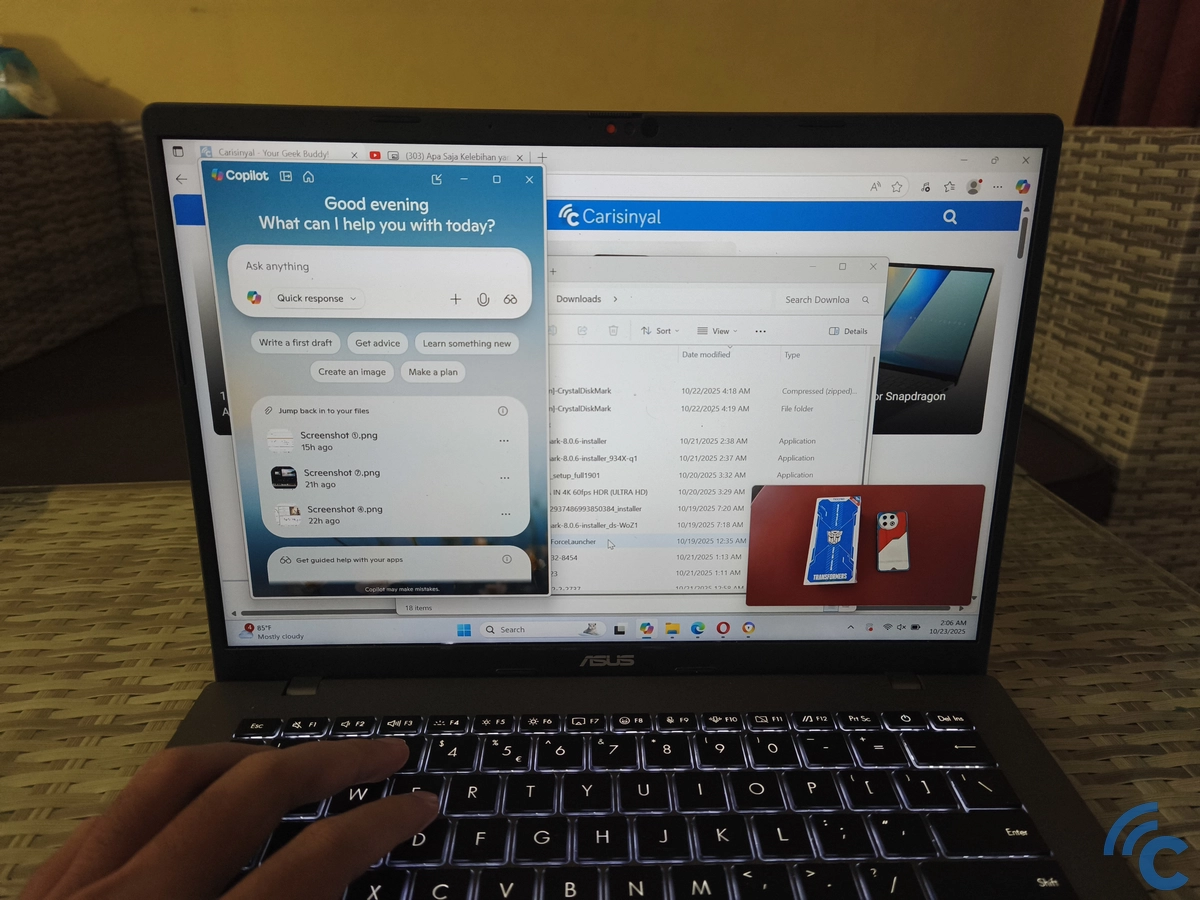
This laptop is equipped with AI-powered technology that enhances performance and manages power efficiently. I had the chance to test this device myself and see how it performs in daily use.
After using it for some time, several aspects stood out to me. In my opinion, the ASUS Vivobook S14 (S3407CA) offers an impressive mix of smart features, solid performance, and excellent power efficiency. Here’s my full review of this laptop.
Sales Package Contents
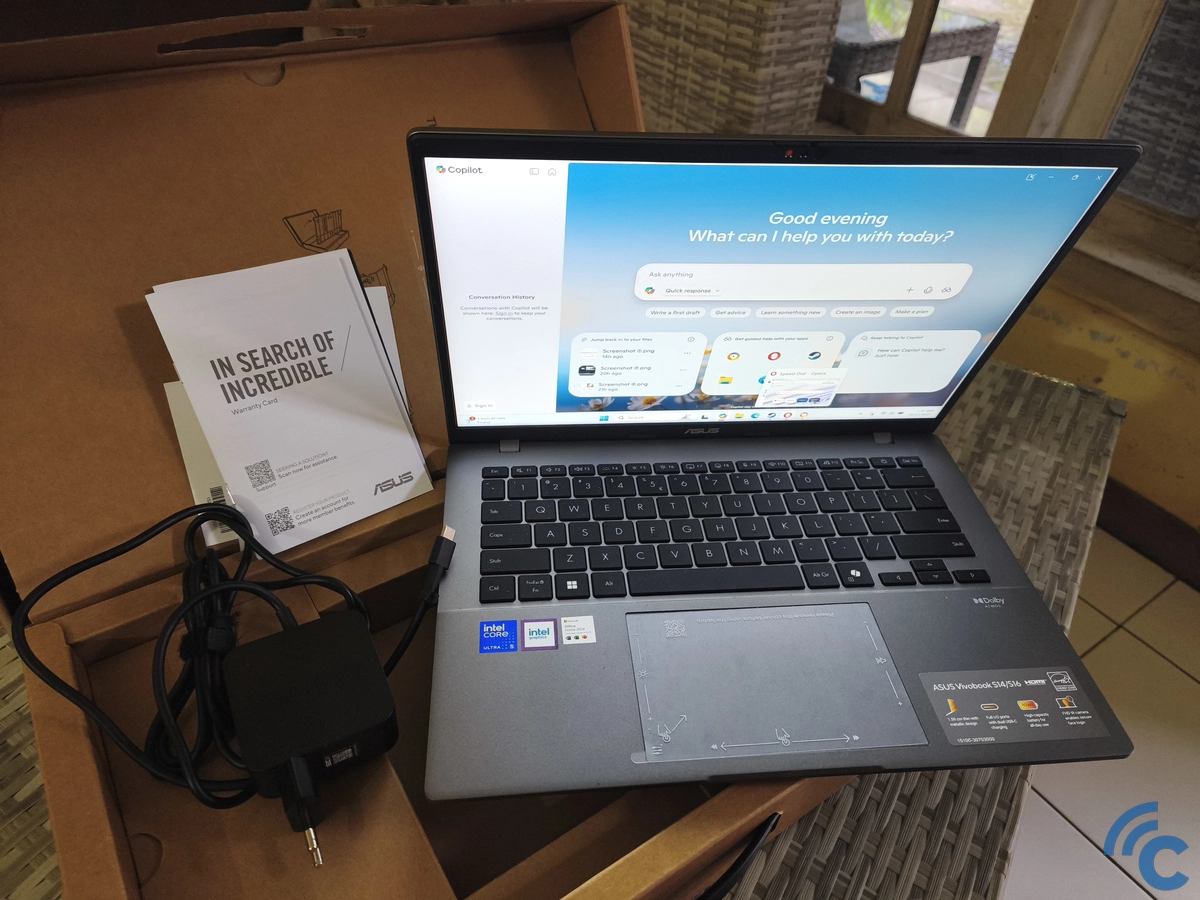
ASUS packs this laptop in a large cardboard box to ensure safety during shipping. The contents are quite simple, nothing unusual compared to other laptops.
Inside, you’ll find the ASUS Vivobook S14 (S3407CA) unit, a Type-C charger that feels modern and practical, a protective sheet, a warranty card, and a few other documents that most people rarely read.
Minimalist and Elegant Design

The design of this laptop looks simple yet elegant. The back cover is plain, with only the subtle “ASUS VIVOBOOK” text that blends into the surface. This clean design gives the laptop a professional and confident look.
The body is made of a dual-metal chassis on both the top and bottom. It not only looks premium but also feels solid and sturdy when held. The ASUS Vivobook S14 (S3407CA) even comes with MIL-STD-810H certification, which ensures protection against drops and minor impacts.
During my use, I feel that its sturdy build is more than just appearance. The hinges feel strong and reliable for a modern laptop. You can open the lid easily with one hand without holding the base. The screen can also tilt up to 180 degrees to provide more flexibility.
The ASUS Vivobook S14 (S3407CA) is truly a comfortable laptop for work. Besides its professional design, it is slim and compact, with a thickness of 1.59 cm at the thinnest point and 1.79 cm at the thickest. It weighs only 1.46 kg, so it's easy to carry anywhere.
Complete Port Selection with USB-C

As a modern laptop, the ASUS Vivobook S14 (S3407CA) uses a USB Type-C charger instead of the older version. The charger itself is small and light, weighing only 225 grams. You can also use other Type-C chargers to power it, so you won’t need to bring multiple chargers when traveling.
The laptop provides a good range of ports. On the left side, there are two USB Type-C 3.2 Gen 1 ports that support power delivery and DisplayPort. You’ll also find one HDMI 1.4 port, one USB Type-A 3.2 Gen 1 port, and a 3.5 mm audio jack.
On the right side, there is one more USB Type-A 3.2 Gen 1 port, along with indicator lights for notifications and charging status.
The number of ports may not be large, but it is practical enough for most users. The inclusion of an HDMI port and two USB Type-C ports with DisplayPort support is especially useful. With these, you can connect up to four screens at the same time, including the laptop’s own display.
Spacious Keyboard and Touchpad with Additional Functions

The keyboard of the ASUS Vivobook S14 (S3407CA) is similar to other Vivobook models. It has a 1.7 mm key travel that feels comfortable to use. While typing, I didn’t notice anything weird since I’ve used ASUS Vivobook laptops before.
Typing feels smooth, and the spacing between the keys is just right. The keyboard also comes with a backlit chiclet feature that can be activated using the F4 key. There are three brightness levels that you can adjust depending on your lighting conditions, especially when typing at night or in a dim room.

One thing to note is actually the position of the power button. The ASUS Vivobook S14 (S3407CA) doesn't place it in the corner or outside the keyboard row.
Instead, it sits between the Prt Sc and Del Ins keys. The button is not as clicky as the others, and because it blends with the main keyboard layout, it may be pressed accidentally at times.
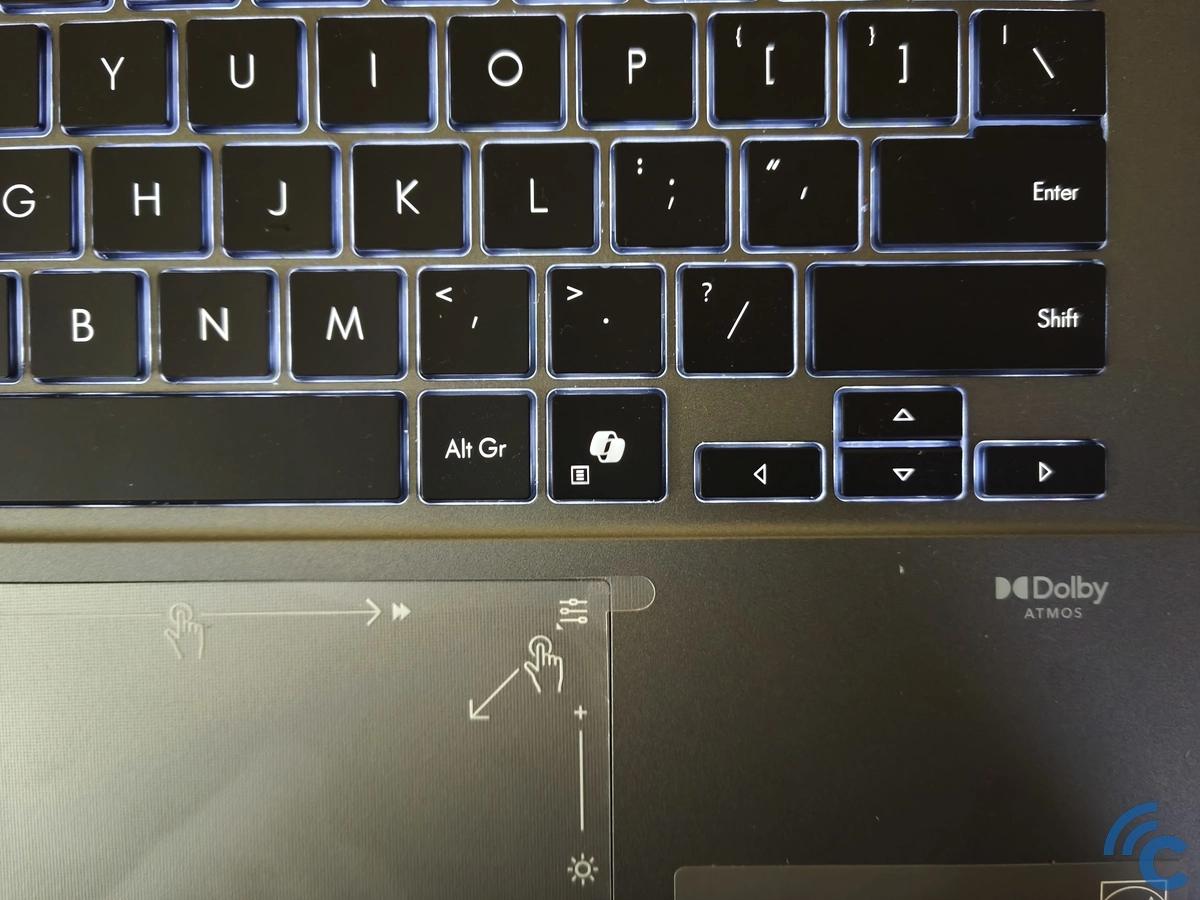
Even with its standard layout, this keyboard includes several special keys. One of them is the CoPilot key, which provides quick access to the AI assistant. By pressing this key, you can search for information or ask for help from the AI instantly.
The touchpad is spacious and responsive. It measures 12.7 x 7.9 cm, stretching from the left Alt key to the CoPilot key.
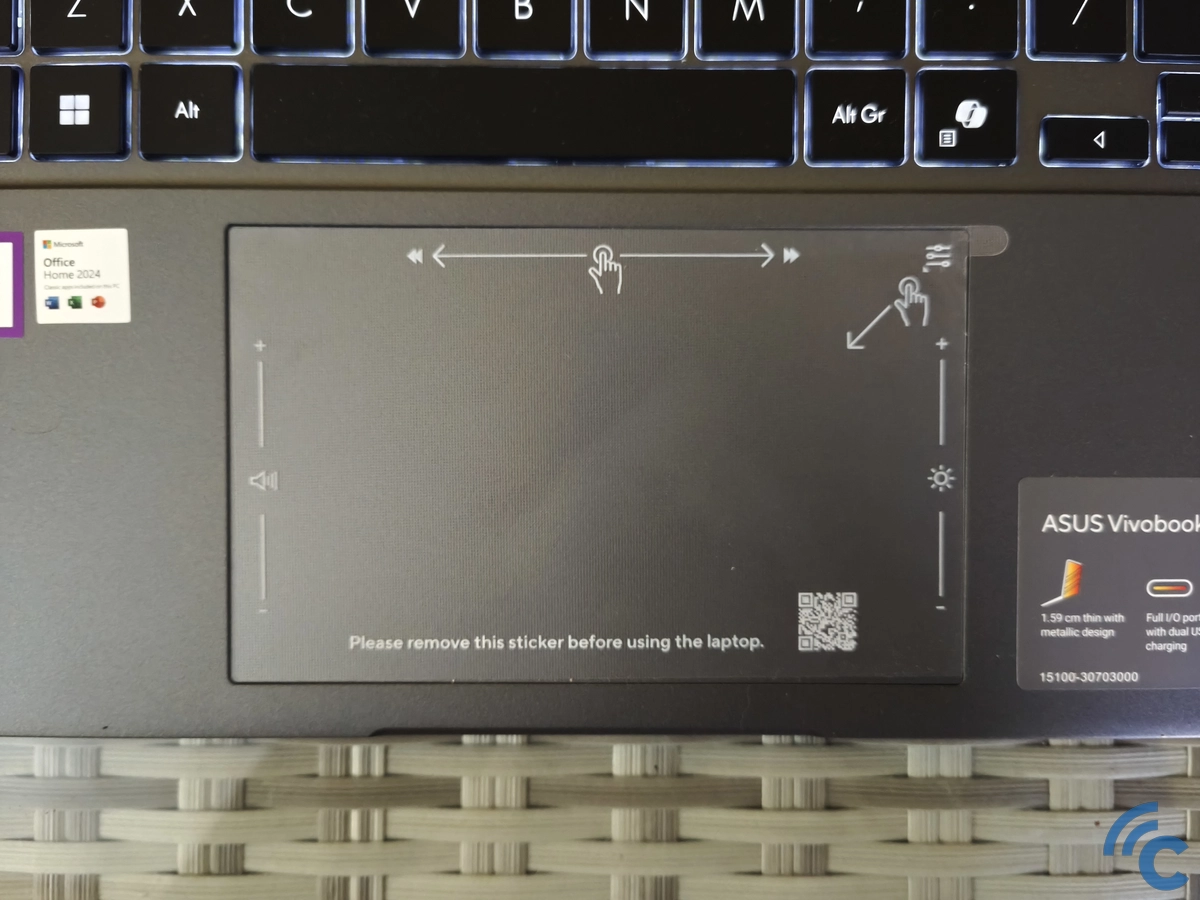
It supports Palm Rejection, so the cursor stays still even if your palm touches the surface. This makes typing more convenient. The touchpad also supports gesture controls for adjusting volume, brightness, and skipping or rewinding media.
Sharp IPS Screen, Easy on the Eyes
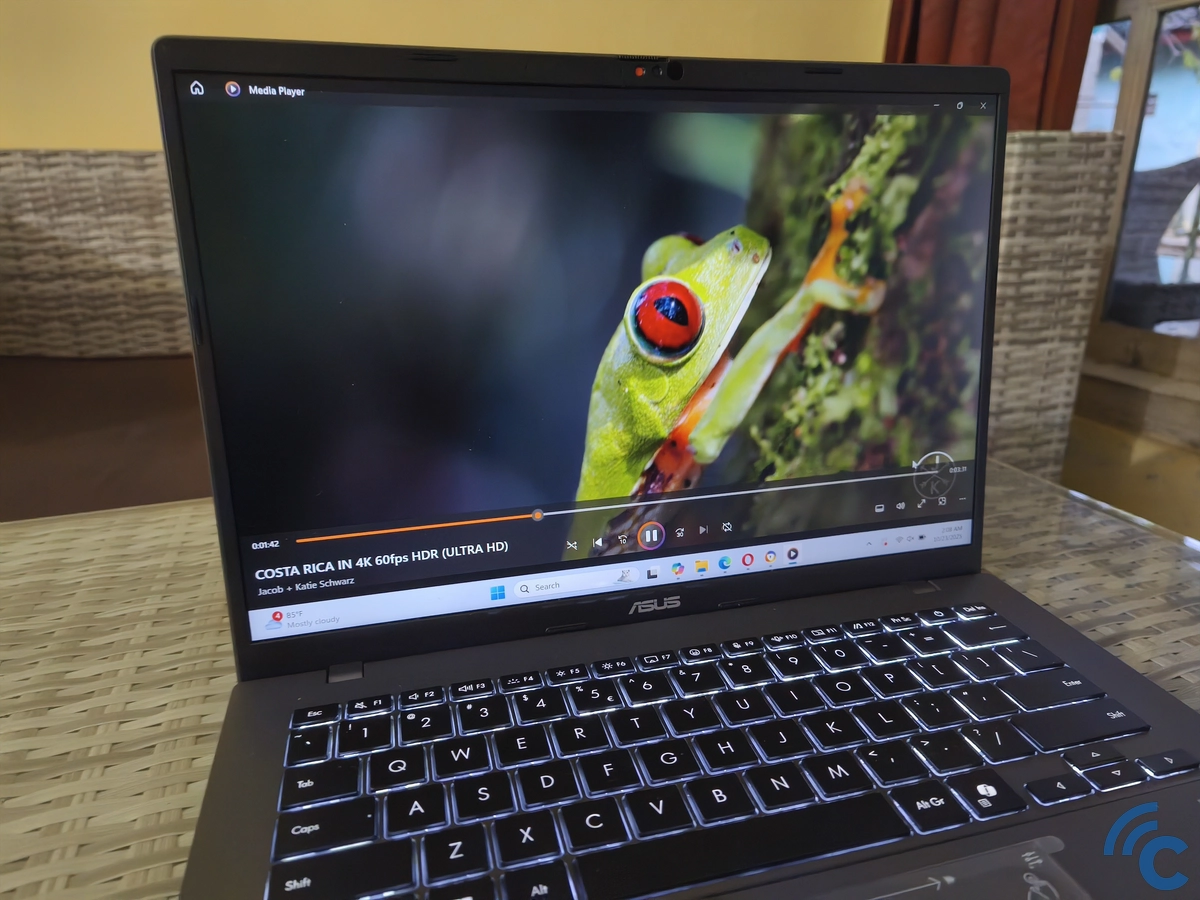
Moving to the display, the ASUS Vivobook S14 (S3407CA) features a standard 14-inch screen. With a 16:10 aspect ratio, it offers enough vertical space for multitasking. Viewing multiple windows at once feels comfortable.
The screen uses an IPS LCD panel with a WUXGA resolution of 1920 x 1200 pixels. For someone like me who often uses laptops with AMOLED panels, the difference is quite noticeable. I usually use the ASUS Vivobook Pro 14 OLED, which focuses heavily on display quality.
Of course, AMOLED screens are superior to IPS LCD in most aspects, especially in color depth and brightness. The contrast is also much higher. However, IPS LCD panels generally give better durability and fewer long-term issues.
At first, the IPS display on this laptop felt a bit "unusual" to me. After about three days of use, I started getting used to it. The screen quality is decent for its price range, though it still falls short of AMOLED standards.
Brightness levels are adequate for indoor use. Watching movies or doing basic editing tasks that don't require high color accuracy still feels enjoyable. The screen also has TUV Rheinland certification that can help reduce eye strain during long hours of use.
The only drawback is the 60 Hz refresh rate. It is considered low for a smoother visual experience, which can slightly affect activities like browsing, scrolling, and casual gaming.
The Speakers Are Not Very Loud, but Still Okay

The ASUS Vivobook S14 (S3407CA) has dual speakers placed at the bottom of the laptop. This placement is actually good because the sound is not blocked by your hands or by the surface when the laptop sits on a table. The MyASUS software also includes sound profiles and an equalizer that let you adjust the audio to your preference.
Even so, the speakers are not very powerful. The volume feels low, especially when watching movies. I often had to turn it up to 100 percent to hear the dialogue clearly. On the bright side, the sound remains clear even at maximum volume without any cracking noise.
Since the sound felt a bit weak, I preferred using earphones when watching movies. The laptop provides a 3.5 mm audio jack for wired earphones or headphones. I also tried using TWS via Bluetooth, and the sound was clearly better, with deeper and clearer tones.
Secure Full HD Webcam with Noise Cancelling
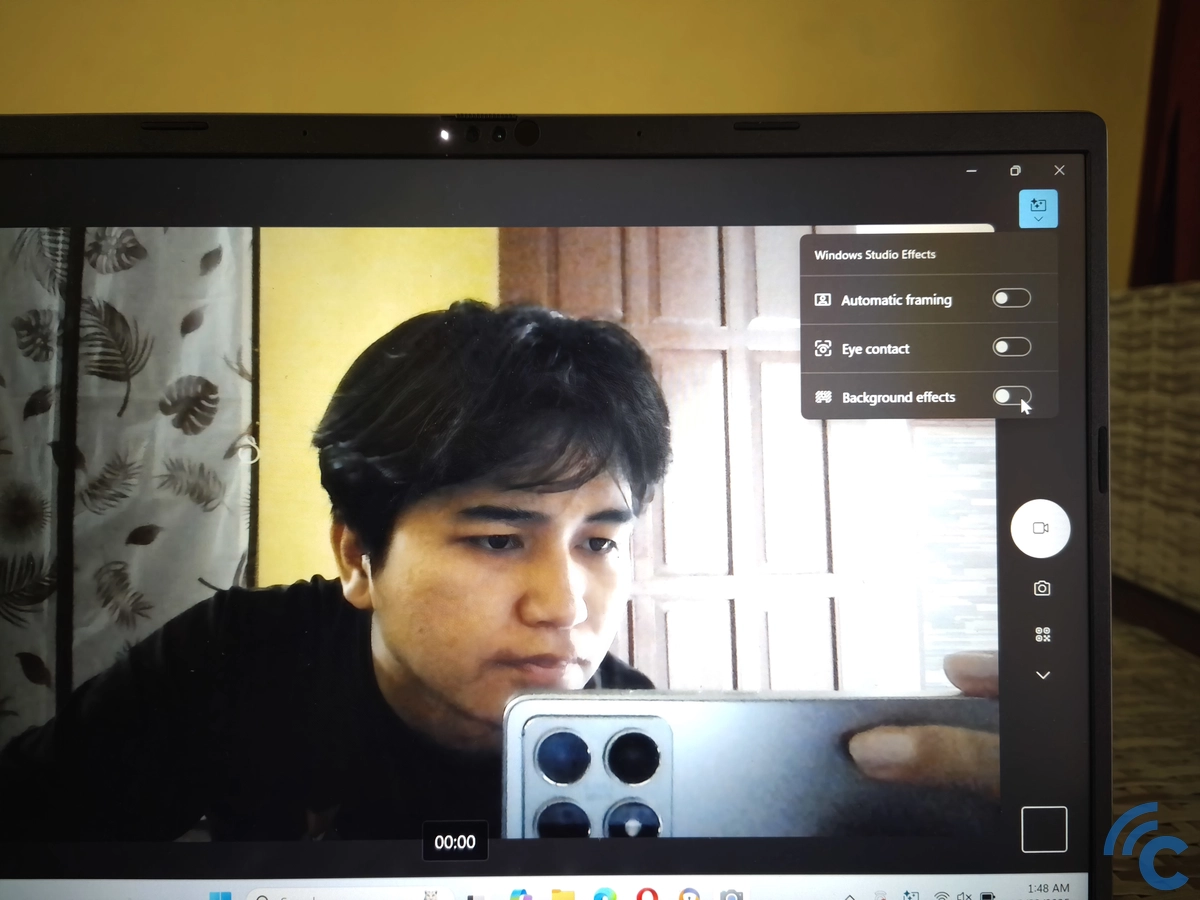
The laptop comes with a front camera that plays an important role for video calls, whether for online meetings or virtual classes. The ASUS Vivobook S14 (S3407CA) is equipped with a Full HD+ webcam that records at 1080p 30 FPS, which, of course, gives a clear and detailed image.
This webcam supports several Windows Studio Effect features. Some examples include Automatic Framing that keeps your face centered, Portrait Light that improves lighting, Eye Contact that helps maintain focus, and Background Effect or Creative Filters for extra style.
These features help improve the quality of your video calls. You can use Eye Contact, Background Effect, or Portrait Light for a more professional appearance. You can also try Creative Filters if you want to make your calls look more fun and casual.
Based on several sources, Windows Studio Effect runs on the NPU instead of the processor. This helps reduce battery usage during video calls. The webcam also includes a privacy shutter for added security to prevent any unwanted camera access.
The microphones are placed on both sides of the camera. ASUS claims they come with AI Noise Cancelling technology to minimize background sounds. When I tested it, the noise was almost completely gone, and my video calls sounded much clearer and more comfortable.
Powerful Intel Core Ultra 7 Performance
ASUS proves once again that it can deliver strong performance in the mainstream laptop market. The ASUS Vivobook S14 (S3407CA) uses an Intel Core Ultra 7 255H processor that handles multitasking very well. It has 16 cores and 16 threads with speeds of up to 5.1 GHz.
The laptop comes with 16 GB of DDR5 RAM, which is already good for its price. If you need more, there is still an empty SODIMM slot for extra memory.
For storage, the laptop uses a 1 TB M.2 NVMe PCIe 4.0 SSD. ASUS also provides an extra SSD slot for expansion, although the existing capacity is already quite large. With 16 GB of RAM and fast SSD storage, performance feels smooth, and even light gaming runs well.
The ASUS Vivobook S14 (S3407CA) handles daily multitasking with ease. It can open dozens of Chrome tabs, switch quickly between Word and Excel, or browse the internet all day without slowing down.
In terms of gaming, it performs well for casual titles. It is not meant for heavy triple-A games at high settings, but it can handle light to moderate gaming when the graphics are adjusted.
To get a clearer picture of its performance, I ran several benchmark tests. These results can serve as a reference for comparing it with other laptops.

In PCMark 10, the laptop scored 6886 points, showing that it performs well for daily tasks and is also power efficient.
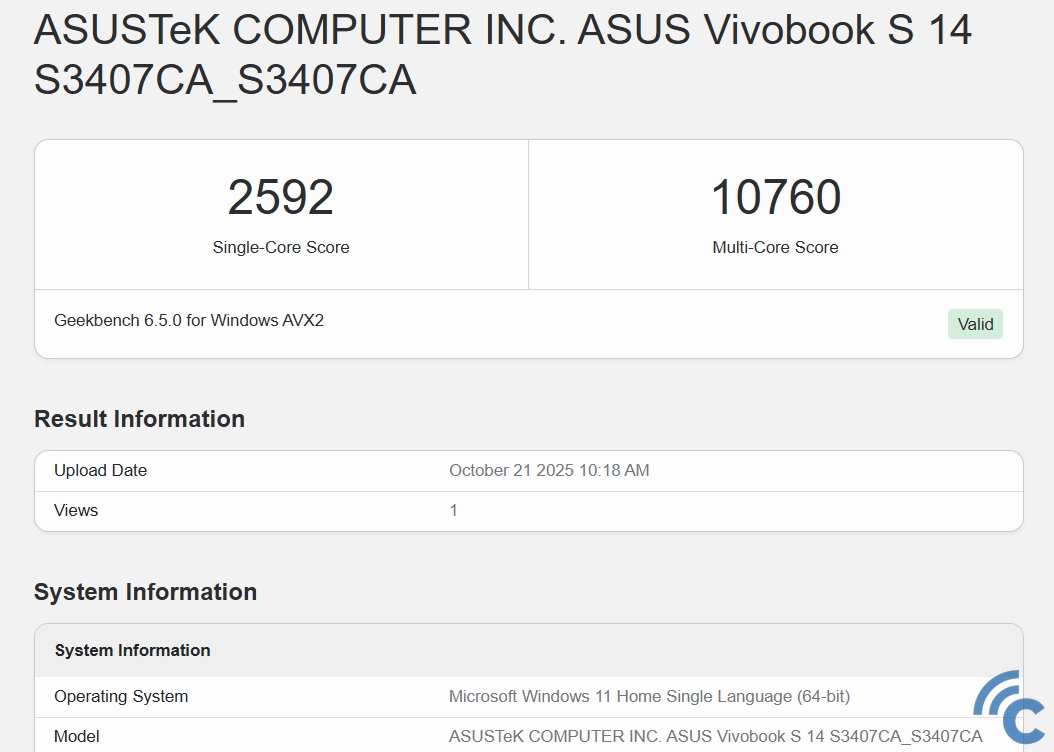
In GeekBench, the laptop scored 2592 points for single-core performance and 10760 points for multi-core. These results indicate solid performance, even though this laptop is not built as a high-end powerhouse.
To check its stability, I also ran Cinebench R23 tests ten times in a row, both when plugged in and when running on battery power.

When plugged in, the multi-core test produced a highest score of 12722 points and a lowest of 12199 points, with an average of 12454.3 points.
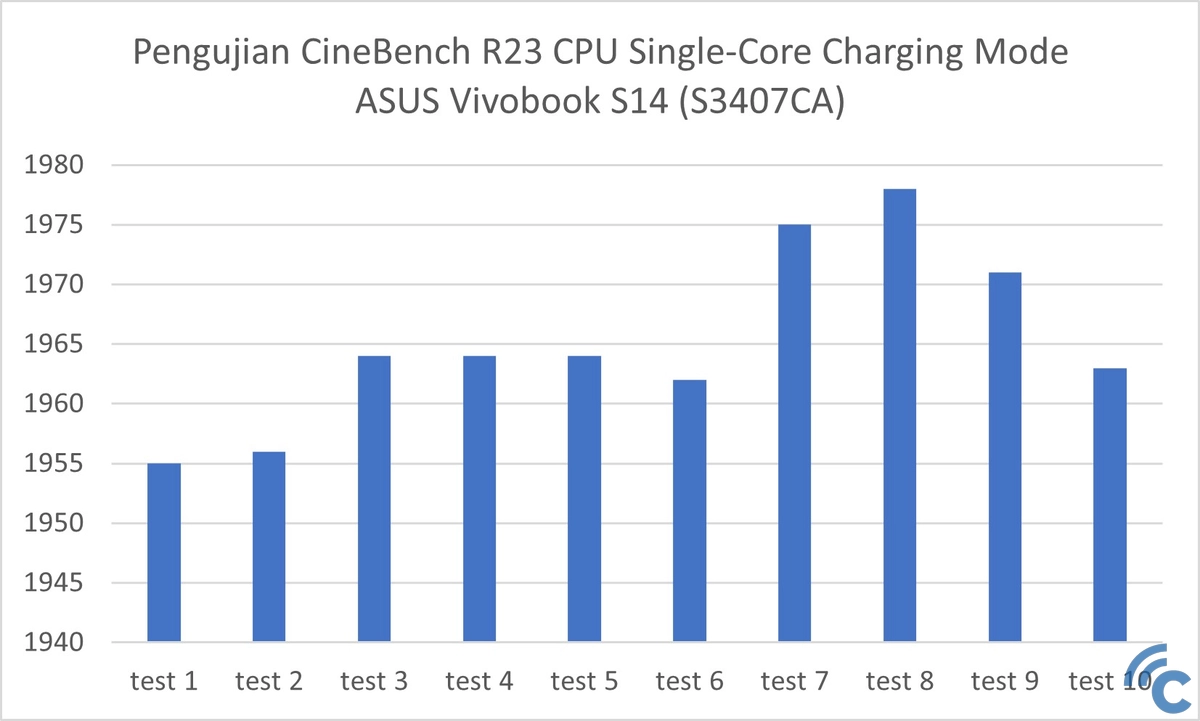
When plugged in, the multi-core test produced the highest score of 12722 points and a lowest of 12199 points, with an average of 12454.3 points. The single-core test recorded a highest score of 1978 points and a lowest of 1955 points, with an average of 1965.2 points.
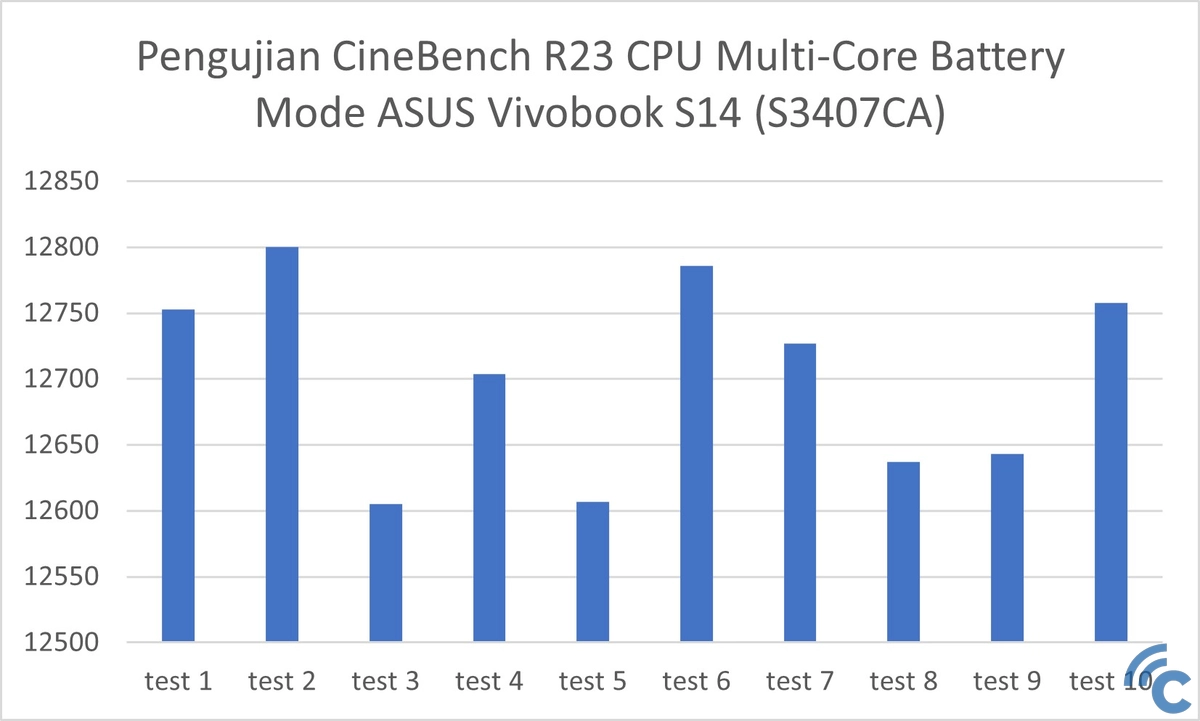
Interestingly, when tested on battery power, the multi-core performance was slightly higher. It reached a highest score of 12800 points and a lowest of 12605 points, averaging 12702 points.
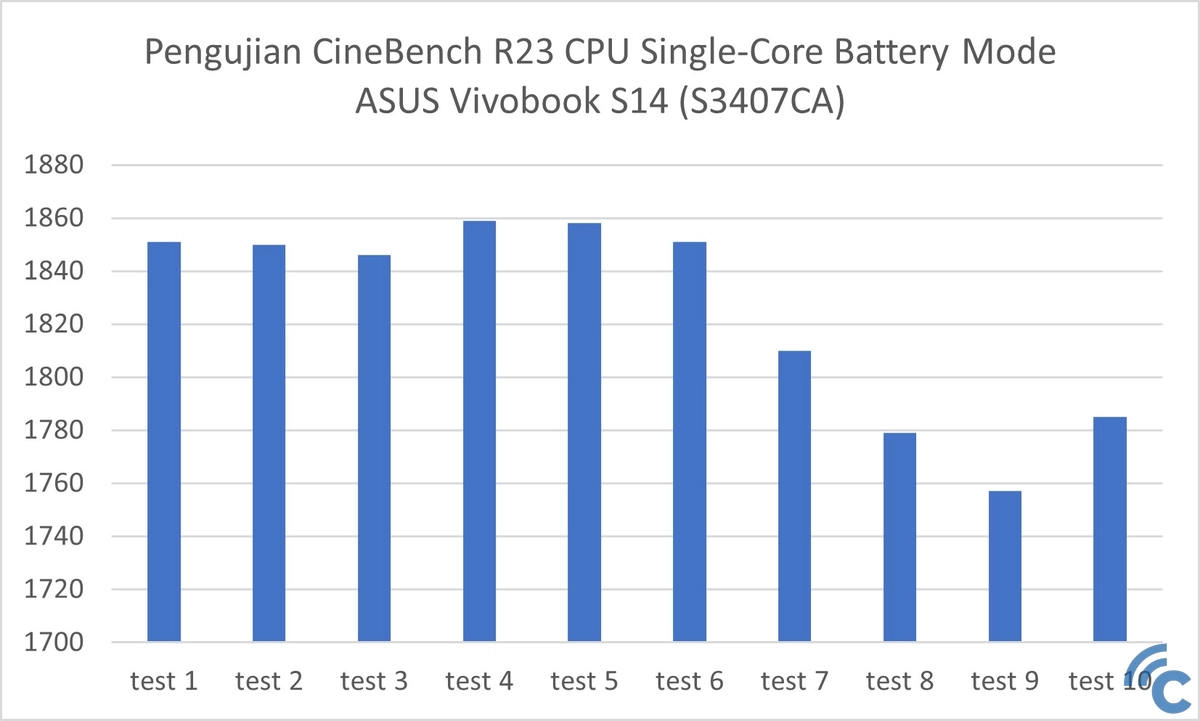
However, the single-core result dropped a bit, with a highest score of 1859 points, a lowest of 1757 points, and an average of 1824.6 points.
The ASUS Vivobook S14 (S3407CA) also features a good cooling system. It has a single heat pipe and one fan that directs hot air toward the back instead of the screen. This helps protect the display from heat while keeping the system stable during heavy workloads.
GPU and Gaming Testing
The Intel Core Ultra 7 255H comes with a powerful NPU (Neural Processing Unit) that delivers up to 13 TOPS of performance. This NPU plays an important role in handling AI-based tasks more efficiently. It has become one of the key features in modern laptops.
The ASUS Vivobook S14 (S3407CA) also offers good graphics performance. It uses an Intel Arc 140 Ti GPU to handle visuals and light graphic tasks. Although this laptop is not built for heavy gaming, its GPU performs well for activities such as photo editing or running AI features.
To check its graphics performance, I used the 3DMark benchmark as a reference. The tests included two parts: Steel Nomad Light Score and Time Spy Score.
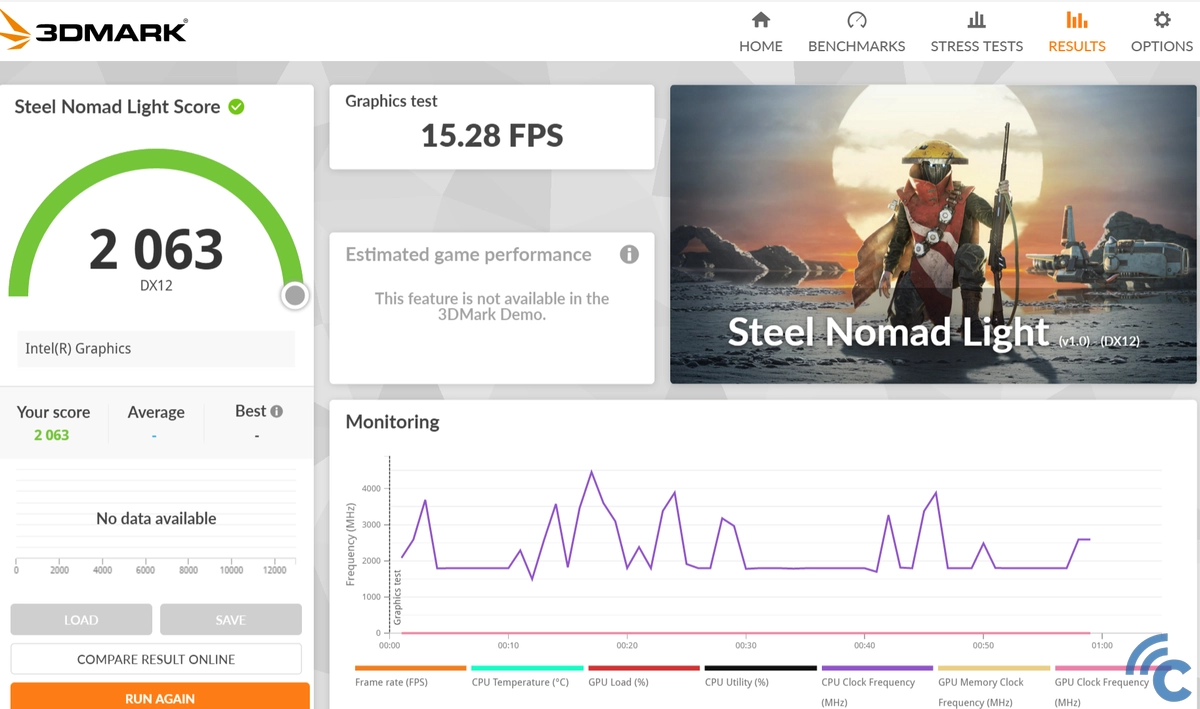
In the 3DMark Steel Nomad test, the ASUS Vivobook S14 (S3407CA) scored 2063 points. This benchmark focuses on high-end graphics performance and tests how well the GPU handles ray tracing at high resolutions.
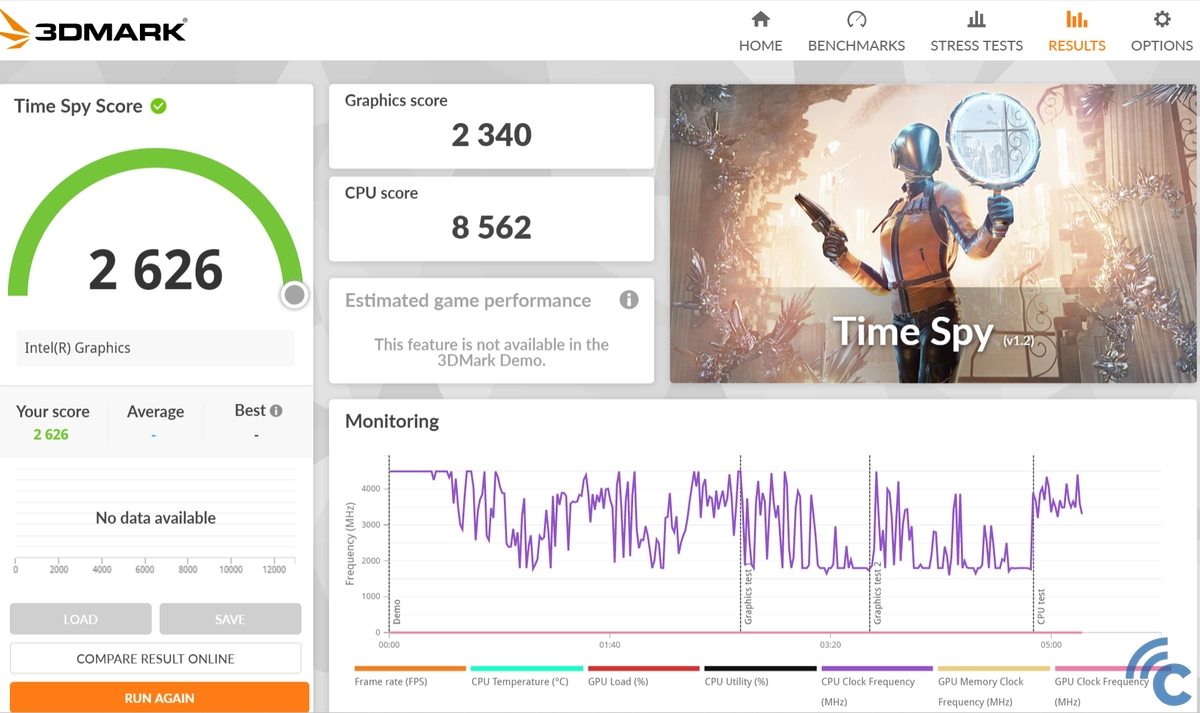
I also ran the 3DMark Time Spy test, and the laptop scored 2626 points, which is quite good for its class.
However, benchmark results alone cannot fully show real-world performance. To understand its true capability, I tested the laptop by playing one of the most popular games known for its impressive graphics quality, Wuthering Waves.
Wuthering Waves Game Testing
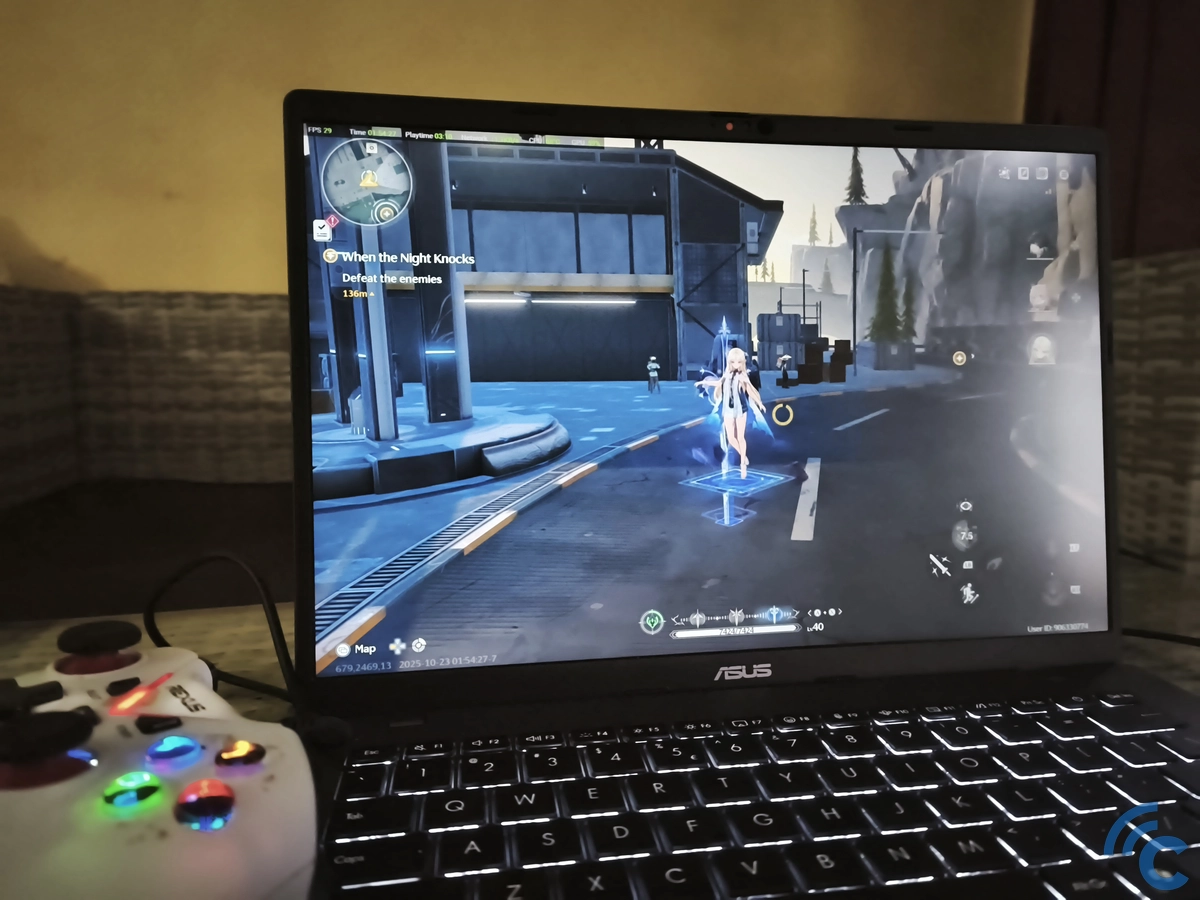
The game I tested was Wuthering Waves, a title that demands strong graphics performance and smooth motion during battles. It is known for its detailed visuals and high system requirements.
For this test, I set the graphics quality to 1920 x 1200 pixels with a 30 FPS frame rate. I expected the laptop to struggle, but the ASUS Vivobook S14 (S3407CA) handled it surprisingly well.
The visuals looked beautiful, with sharp colors and fine details. During battles, the gameplay remained smooth without frame drops or lag. I could play for a long time comfortably, and the experience felt enjoyable overall.
Testing AI Capabilities with GeekBench AI
Since this laptop supports AI features, I decided to test its performance using the GeekBench AI benchmark. This application is designed to measure how well a device handles AI computing tasks.
One interesting thing about GeekBench AI is that it tests not only speed but also accuracy. It includes three types of subtests: Single Precision (32-bit), Half Precision (16-bit), and Quantized Precision (8-bit). The results are shown in points, similar to other benchmark tests.
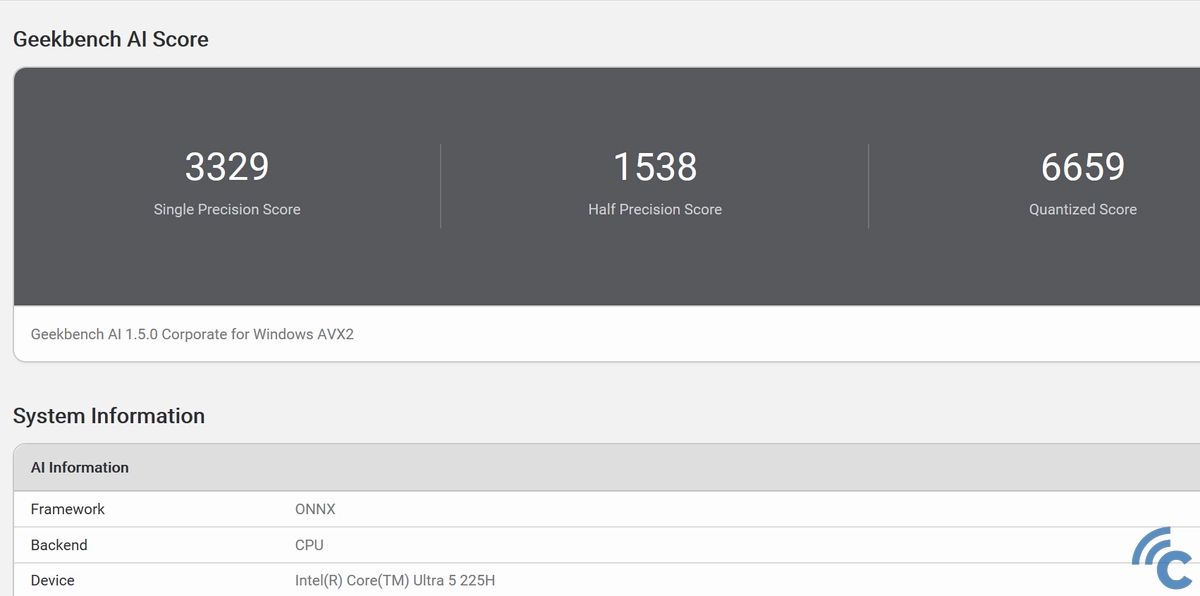
I first tested the CPU performance, and the scores were quite good. The ASUS Vivobook S14 (S3407CA) achieved 3329 points for Single Precision, 1538 points for Half Precision, and 6659 points for Quantized Precision.
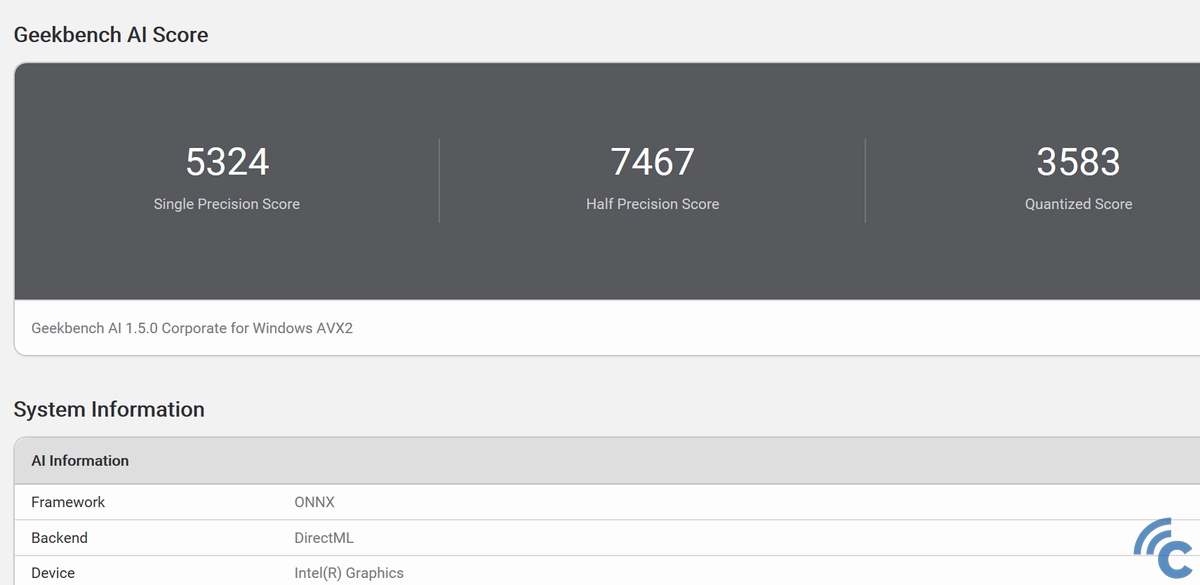
Next, I tested the GPU or DirectML performance. The results were even higher, with 5324 points for Single Precision, 7467 points for Half Precision, and 3583 points for Quantized Precision.
Overall, the ASUS Vivobook S14 (S3407CA) performs very well as a smart laptop for daily use. The high scores show that its Neural Processing Unit (NPU) can handle AI and Machine Learning workloads quickly and efficiently.
The test also shows that its AI processing speed is excellent for practical tasks. It can manage real-time image and video processing, accurate voice transcription, and smooth performance in creative or professional apps that use AI technology.
Spacious SSD Storage Testing
The ASUS Vivobook S14 (S3407CA) uses a 1 TB M.2 NVMe PCIe 4.0 SSD. This type of SSD provides fast data read and write speeds, which helps when booting, loading apps or games, and transferring files.
With a capacity of 1 TB, the storage is more than enough for long-term use. It can hold the operating system, various applications, games, and personal files. If you still need more space, the laptop has an extra SSD slot that allows you to upgrade the storage capacity.
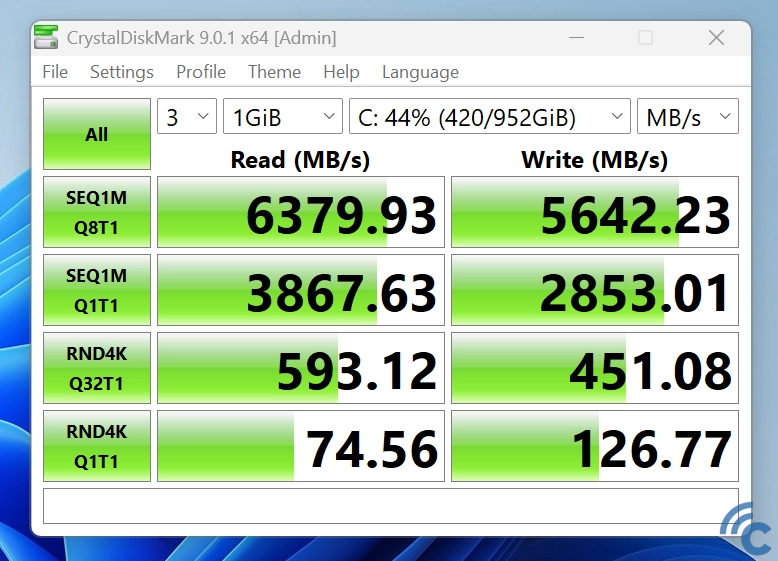
I tested the SSD performance using CrystalDiskMark, and the results were excellent. The Sequential Read speed reached 6379.93 MB/s, while the Sequential Write speed reached 5642.23 MB/s.
These numbers show that the SSD performance of the ASUS Vivobook S14 (S3407CA) is outstanding. Its large capacity and fast speed make daily work more efficient, especially when paired with a capable processor and AI features that boost performance.
Video Rendering Testing on a Casual Platform

The ASUS Vivobook S14 (S3407CA) is more focused on productivity than gaming. Its AI features make it ideal for tasks that require consistency and speed, such as content creation. This laptop can be a good option for users who often edit videos.
To see how it performs, I tested video rendering using two popular editing programs, CapCut and Filmora. The video used was a 4K clip with a duration of about five minutes, and the goal was to render it into 1080p resolution.
On CapCut, the rendering process finished in about 1 minute and 1 second, which is an impressive result. On Filmora, it took slightly longer, about 2 minutes and 6 seconds, which is still quite fast for a casual editing setup.
Battery Life and Charging Test
The ASUS Vivobook S14 (S3407CA) is powered by a 70Wh 4-cell lithium-ion battery. ASUS claims that it can last up to 20 hours of continuous video playback. To check this, I tested it myself by playing videos repeatedly from a full 100 percent battery until it ran out completely.
The video used was in 4K resolution. I adjusted several settings for fairness: WiFi and Bluetooth were turned off, the volume was set to 50 percent, and screen brightness was also set to 50 percent. The result was 16 hours and 57 minutes of battery life. This is still quite impressive, even though it is slightly below ASUS’s claim.
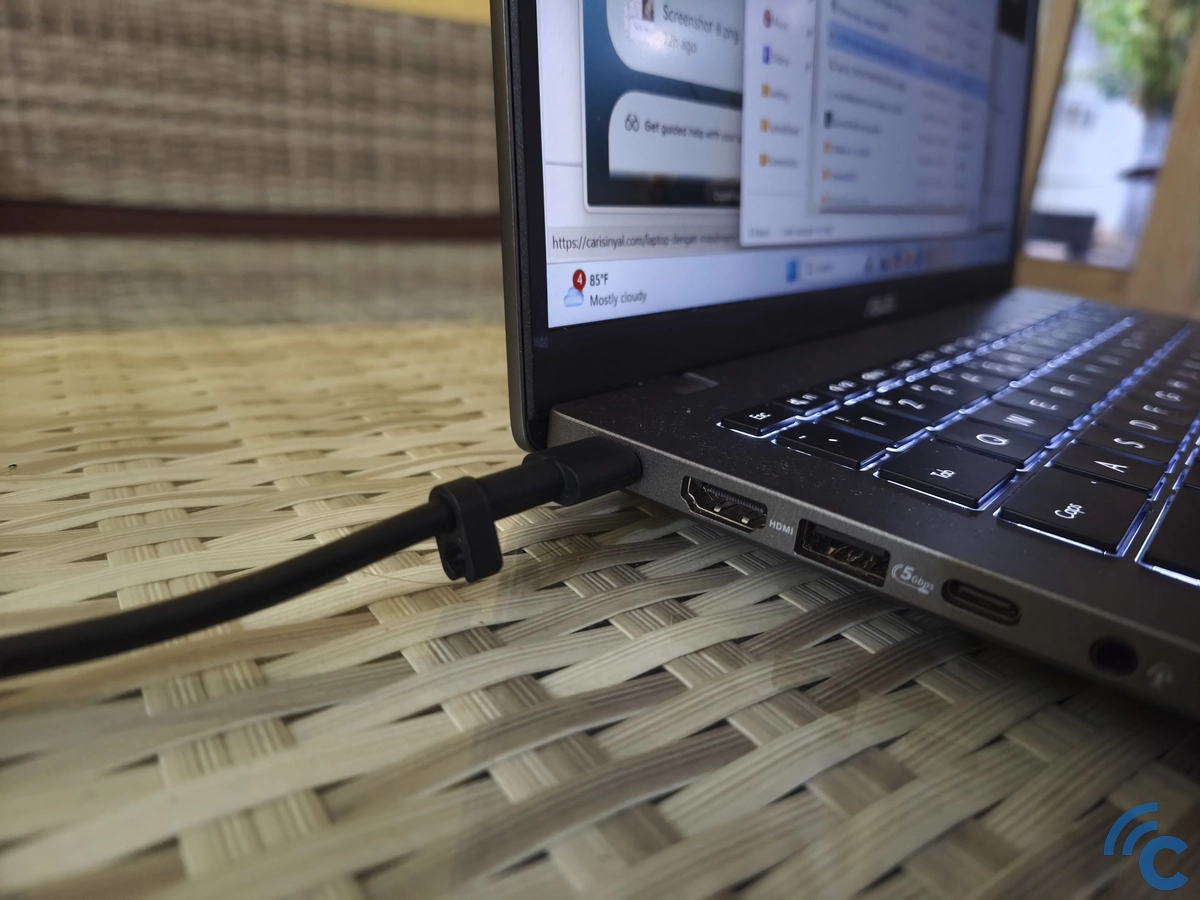
Charging performance is also good for its class. The laptop uses a 65W Type-C charger, which ASUS claims can fully charge the battery in under two hours. I tested this as well to confirm the result.
From 0 to 100 percent, the ASUS Vivobook S14 (S3407CA) took 1 hour and 52 minutes to charge completely. The claim is accurate. In fact, the battery reached 95 percent even faster, but it took a bit longer to reach full capacity.
Conclusion
After testing various aspects, I can say that the ASUS Vivobook S14 (S3407CA) is one of the most appealing laptops in its price range. It offers strong overall performance with reliable specifications. I particularly like its minimalist design and sturdy build, which give a sense of durability and quality.
This laptop also has several standout features. It offers long battery life, fast charging, and a clear webcam that works well for meetings or online classes. Its daily performance is smooth thanks to the modern processor and AI-powered features.
Still, there are a few areas that could be improved. The laptop does not use an OLED panel, the speakers are quite standard, the power button placement could be better, and its gaming performance is not very strong.
Even so, the ASUS Vivobook S14 (S3407CA) remains a great choice for students, professionals, and casual users who want a smart, efficient, and reliable laptop for everyday tasks.
Pros of ASUS Vivobook S14 (S3407CA):
- Minimalist design with a sturdy and solid metal build.
- The hinge can open up to 180 degrees and feels premium when adjusted.
- Complete port selection, including two USB-C and one USB-A ports, allowing the use of up to four screens at once.
- Spacious keyboard with backlit keys and a dedicated CoPilot button for easier AI access.
- Wide touchpad with extra functions for adjusting brightness, volume, and media playback.
- Comfortable 16:10 screen ratio with TUV Rheinland certification that helps reduce eye strain.
- Full HD+ webcam with Windows Studio Effect and AI Noise Cancelling microphone.
- Powerful Intel Core Ultra 7 processor that performs well for heavy daily use.
- Smooth multitasking supported by the Intel Arc 140 Ti GPU and AI-based features.
- Can still run casual games such as Wuthering Waves with adjusted settings.
- Long battery life that can last up to 16 hours of video playback or daily activities.
- Fast charging that takes less than two hours to go from 0 to 100 percent.
Cons of ASUS Vivobook S14 (S3407CA):
- The power button placement is not ideal and can be pressed accidentally while typing.
- The screen still uses an IPS LCD panel instead of OLED, which offers more vibrant colors.
- The refresh rate is limited to 60 Hz.
- The stereo speakers are not very loud, although still acceptable for the price range.
